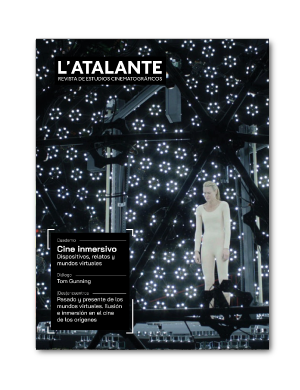El teatro total de Erwin Piscator como herramienta audiovisual inmersiva revolucionaria. El paradigma de 'Hoppla, Wir Leben!' (1927)
Publicado 01.01.2023
Palabras clave
- Teatro-Cine,
- Inmersividad,
- Piscator,
- Teatro político,
- Teatro revolucionario
- Dispositivo,
- Masas,
- Proletariado. ...Más
Cómo citar
Derechos de autor 2023 L'Atalante. Revista de estudios cinematográficos

Esta obra está bajo una licencia internacional Creative Commons Atribución-NoComercial-SinDerivadas 4.0.
Resumen
Este artículo se encuadra en la dimensión inmersiva del, cada vez más en boga, diálogo entre teatro y cine; un diálogo que, en realidad, se remonta a los inicios del medio cinematográfico y que se ha prolongado hasta nuestros días en forma de todo tipo de experimentos que han ido incorporando las técnicas y tecnologías de cada época. Un punto de inflexión clave en esta relación tendrá lugar en la alemana República de Weimar, un contexto sociopolítico muy concreto que hará que el uso de la imagen cinematográfica en la escena y su vocación inmersiva adquieran tintes revolucionarios, siendo el director Erwin Piscator quien sistematice el uso de la película como elemento cohesionador en un ideal de teatro total profundamente ligado a las vanguardias históricas, y al servicio del ideario marxista. Esto hará de él un eslabón clave en la cadena que iría desde la precinematografía hasta las propuestas actuales de teatro documental y político, en el que se empezarán a vislumbrar una serie de características —especialmente a partir del montaje Hoppla, Wir Leben! [¡Alehop, estamos vivos!] (Ernst Toller, 1927)— que marcarán indefectiblemente la interacción entre la escena y las pantallas.
Descargas
Citas
-Albera, F. & Tortajada, M. (2015) The Dispositive Does Not Exist! En Albera, F. & Tortajada, M. (eds.). Cine-Dispositives: Essays in Epistemology Across Media (pp. 21-44). Amsterdam: Amsterdam University Press
-Balázs, B. (2010). Early Film Theory. Visible Man and The Spirit of Film. New York y Oxford: Berghahn
-Benson, R. (1984). German Expressionist Drama. Ernst Toller and Georg Kaiser. Londres: MacMillan Press
-Bourriaud, N. (2006). Estética relacional. Buenos Aires: Adriana Hidalgo Ed.
-Braun, E. (1982). The Director and the Stage: From Naturalism to Grotowski. Nueva York: Holmes & Meier
-Deleuze, G. (1984). La imagen movimiento. Barcelona: Paidós
-Fuchs, E. (1985). Presence and the Revenge of Writing: Re-Thinking Theatre after Derrida. En PAJ, 9.2-3, pp. 163-173
-Giesekam, G. (2007). Staging the Screen. The Use of Film and Video in Theatre. Londres: Palgrave Macmillan
-Goffman, E. (1986). Frame Analysis: An Essay on the Organization of Experience. Boston: Northeastern University Press
-Klaver, E. (1995). Spectatorial Theory in the Age of Media Culture. NTQ, 11, pp. 309-321
-Kranich, F. (1929/1933). Bühnetechnik der Gegenwart. Vol. II y II. Munich y Berlín: Oldenbourg
-Lehmann, H-TH. (2016). Teatro posdramático. Murcia: CENDEAC
-Lorang, J. (1987). Fenómenos escénicos y teatrales en la Alemania de los años veinte. En Debats, 22, pp. 151-157
-Loup, A. J. III (1972). The Theatrical Productions of Erwin Piscator in Weimar Germany: 1920-1931. LSU Historical Dissertations and Theses, 2348. Recuperado de: https://digitalcommons.lsu.edu/gradschool_disstheses/2348
-Martínez, C. (2021). Reflexiones en torno a las experiencias cinematográficas expandidas como formas de escenografía virtual utópicas. En Escena Uno. Escenografía, dirección de arte y puesta en escena, núm. 14, julio, Universidad del Centro de la Provincia de Buenos Aires
-Mekas, J. (2017), en Cuaderno de los sesenta. Escritos 1958-2010. Buenos Aires: Caja Negra
-Meyerhold, V. (2008). Coloquio con un grupo de jóvenes arquitectos. En Hormigón, J.A. (ed.). Meyerhold: Textos teóricos (pp. 241-244). Madrid: Asociación de Directores de Escena
-Moholy-Nagy, L. (1924). Theater, Zirkus, Varieté. En Gropius, W. y Moholy-Nagy, L. (eds.) Die Bühne im Bauhaus. Bauhausbüchern, 4. Munich: Albert Langen Verlag
-Jordan, K. y Packer, R. (eds.) (2003). Multimedia: From Wagner to Virtual Reality. Nueva York: WW Norton & Co
-Picon-Vallin, B. (1998). Hybridation spatiale, registres de présence. En Picon-Vallin (dir.). Les écrans sur la scène: Tentations et résistances de la scène face aux images (pp. 9-35). París: Éd. L’Âge d’Homme
-Piscator, E. (1927). Cuaderno de dirección de Hoppla, Wir Leben! / Ernst Toller/ Bearbeitung der Piscator-Bühne. Piscator-Sammlung 265. Archivs Akademie der Kunste Robert-Koch Platz. Berlín. Permalink: https://archiv.adk.de/objekt/1820653
-Piscator, E. (2001). El teatro político. Hondarribia: Hiru
-Prieto, J. I. (2013). Teatro Total: arquitectura y utopía en el período de entreguerras. Buenos Aires: Nobuko
-Rancière, J. (2010). El espectador emancipado. Buenos Aires: Manantial
-Romaguera, J. y Alsina, H. (2007). Teatro y cine. En Ibíd. (eds.) Textos y manifiestos del cine (pp. 433-449). Madrid: Cátedra.
-Sánchez, J. A. (2002). Dramaturgias de la imagen. Cuenca: Universidad de Castilla-La Mancha
-Sánchez, J. A. (2011). Dramaturgia en el campo expandido. En VV. AA. Repensar la dramaturgia (p. 19-37). Murcia: CENDEAC.
-Szondi, Peter (2011). Teoría del drama moderno : (1880-1950). Tentativa sobre lo trágico. SL Dykinson
-Toller, E. (1983). Hoppla, Wir Leben! Berlín: Deutschen Theaters Berlin
-Toller, E. (2019). Hop là! Nous vivons! París: Hachette
-Youngblood, G. (1970) Expanded Cinema. New York: P. Dutton & Co., Inc.
-VV.AA. (1927). Programm der Piscatorbühne, núm. 1, Septiembre 1927
-Weiss, P. (2017). Notas sobre el Teatro-Documento. Revista Conjunto, núm. 185. http://casadelasamericas.org/publicaciones/revistaconjunto/185/03PeterWeiss.pdf

